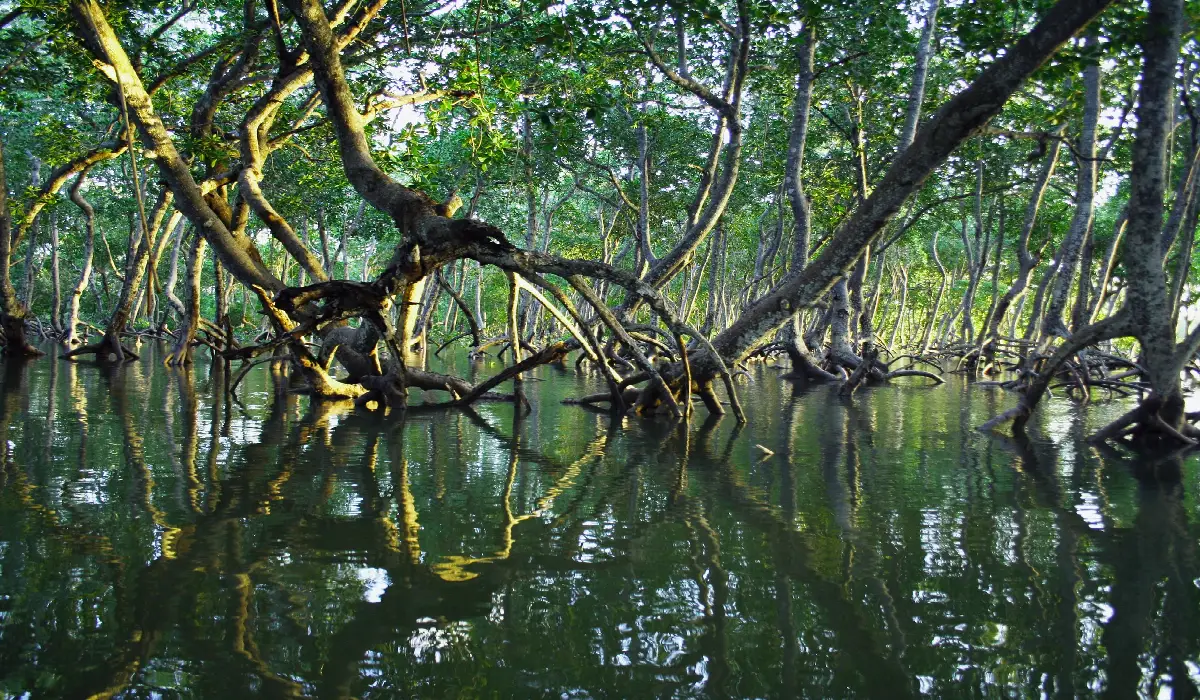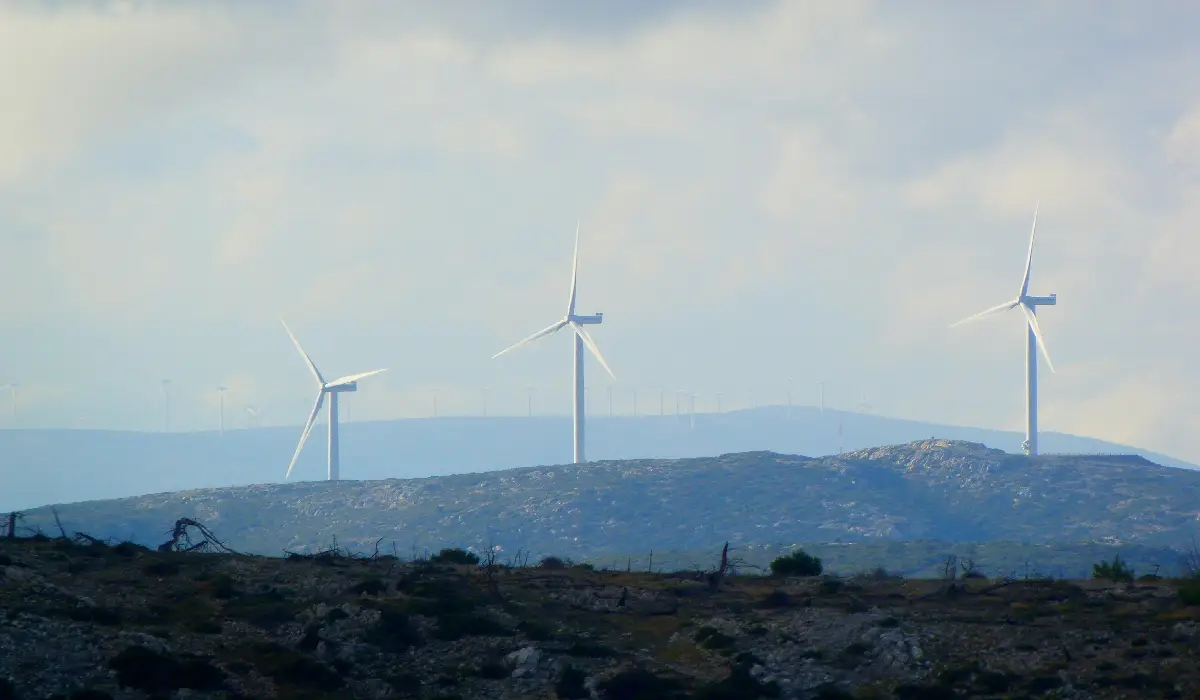In pursuit of the following disasters, marine experts called for restoration of coastal vegetation giving more emphasis on Mangrove forests, which they said will act as a bio-shield protecting lives of residents in the coastal region. So basically what are these mangroves?. By living in dark, muddy and smelly regions with their roots submerged in water, how do they act upon earth? How are they connected with human lives ?. Let’s find out
Long Story Short
- What are Mangroves?
- Adaptations
- Where are they found?
- As an Ecosystem
- Physical environment and threads
- References
What are Mangroves?
A Mangrove is a small tree or shrub that grows along the coastlines by taking roots in salty sediments. They are twice daily exposed to the ebb and flow of tides, fortnightly spring and neap tides and seasonal fluctuations. These distinctive habitats of tropical and subtropical estuaries are distributed in North and South of the equator upto a latitude of 30°.
About 110 species are considered mangroves, in the sense of being trees that grow in such a saline swamp. And generally They can be divided into two according to their habitats in nature: true mangroves and mangrove associates. True mangroves refer to species that specifically grow in intertidal zones, such as Rhizophora apiculata, Kandelia candel, Ceriops tagal, Bruguiera gymnorrhiza, Aegiceras corniculatum, Sonneratia caseolaris; while mangrove associates are capable of occurring in both littoral or terrestrial habitats, such as Hibicus tilisaceus and Excoecaria agallocha.
In fact, there are numerous species of mangroves that aren’t closely related to one another, but they do share the unique capability of growing within the reach of the tides in salty soil. The word Mangrove is derived from a Portuguese word ‘Mangue’ which means tree and the English word ‘Grove’ which means trees or shrubs that are found in shallow or muddy areas. Scientists also refer to mangrove forests as Mangals.
Adaptations
Mangroves are uniquely adapted for thriving in saline intertidal zones. They can survive under extreme hostile environment conditions. Normally the salinity ranges from 3 to 27 parts per thousand, sometimes it can extend upto 75 ppt, still they thrive. The absorbed salts by mangroves are excreted through different methods and they can be categorized into two; Secretors and Non-secretors. In Red mangroves (Non-secretors), the plant creates a barrier by completely inhibiting the entry of salt to it’s vascular system. And this barrier acts against osmosis.
On the other hand, there are many mangroves who deal with the entry of salt or can be called as secretors. In the case of black mangroves, they push out salt through special pores or salt glands within their leaves. As the salty water evaporates, noticeable salt crystals often form on the surface of the leaves. The leaves of some mangroves can also store unwanted salt. Since leaf cells can hold a large volume of water when compared to all other cells, salt is drawn to the leaves as a mechanism to balance the salt concentration. Due to the limited availability of freshwater, mangroves also have limits in the amount of water loss through their leaves.
They have a thick waxy cuticle or dense hairs on their leaves which helps to reduce transpiration or they also vary the orientation of their leaves to avoid the harsh midday sun. The thick fleshy leaves are called succulents. The next challenge that mangroves face as a plant is the utilization of oxygen. Most of the plants can easily take up oxygen from the surrounding soil, but for mangrove roots this is not an option and they need access to air.
This unique environment allowed for the evolution of a variety of special structures that help the underground roots gain access to air, even when submerged by the tide. Pneumatophores are specialized roots that act like snorkels when partially flooded and have pores called lenticels that cover their surface where oxygen exchange occurs. The lenticels contain substances that are hydrophobic in nature which they can repel water, so when submerged, water cannot flood into the root.
Where are they found?
The Mangroves are vastly extended upto more than one hundred countries and territories in sheltered tropical and subtropical coastal areas across the globe. The distribution density and species composition of mangrove forest are determined through the factors like water and air temperature during winter, exposure to wave action and tidal currents, the range of the tide, the nature of the sediments and the chemical composition of the seawater.
Asia has the largest distribution of Mangroves followed by Africa, Northern and Central America, Caribbean, Oceania and South America. According to the studies conducted earlier, out of the total Mangrove population, ≈75% of Mangroves are found in just 15 countries globally. The temperature is the major factor which restricts Mangroves to certain boundaries. The cooler temperatures of northern temperate regions proves too much for the Mangroves.
They do not tolerate frost but can cope with the air temperatures down to 5°C. And this is closely related to seawater temperature. The species number tends to decrease with distance from the equator. Due to the hot and cold ocean current pattern, Mangroves can be found on the Landmasses of eastern edge in the southern Hemisphere.
As an Ecosystem
Mangrove ecosystems are one of the major types of natural wetlands along the tropical and subtropical shores which play a vital role in the estuarine ecosystem. They make up one of the most productive and biologically diverse ecosystems on the planet. They thrive in diverse conditions like growing in the depth of salt water, with roots sticking out of the mud, with fishes, crustaceans and also being a host for other species living between the tree trunks. Mangroves act as a bridge connecting land and sea. In some parts of the globe, the Mangroves even make up to form an aquatic forest.
The Sundarbans forest, a UNESCO World Heritage Site at the mouth of the Ganges, Brahmaputra and Meghna rivers in the bay of Bengal fronting India and Bangladesh is a network of muddy islands and waterways that extends roughly 3,860 square mile is an example of such an ecosystem. Mangrove forests are important feeding grounds for thousands of species and play a major role in the food web. Some organisms like crabs and insects directly eat up the leaves, while others wait for the Mangrove leaves to fall to the ground and consume the decaying materials.
The microbes and fungi which are living in the roots use the decaying materials as fuel and in return they recycle nutrients like nitrogen, phosphorus, sulfur, iron for the mangroves. Being an interface between marine and terrestrial ecosystems, Mangroves support unique fauna with high biodiversity by providing habitats, nurseries, shelter and feeding areas for various animals such as reptiles, birds, mammals, fishes and shrimps. Major factor responsible for the vast diversity is the habitat complexity structured by mangrove vegetation such as prop roots, pneumatophores, trunks and fallen branches.
The greater habitat complexity provides shelter from predation, increased microhabitat availability and abundant food. The root system of mangroves helps to enhance the sedimentation rates and they also harbour epiphytic algae on their surface area, thereby enabling large numbers of small invertebrates. Other organisms like monkeys, birds, insects and other plants rely on the mangrove branches. The Pygmy three-toed sloth, listed as critically endangered on the IUCN Red list, lives predominantly among Rhizophora Mangle trees. And the endangered Mangrove Hummingbird, Amazilia boucardi, feeds on the sweet nectar from the rare Pacific mangrove, Pelliciera rhizophorae.
The mangrove roots are also a great hideout place for small creatures like snails, worms, anemones, barnacles and oysters to avoid predation. More than 50% of global fish and shellfish harvests have been linked directly or indirectly to estuarine nurseries, which explains why higher fish species richness is found in the mangrove habitat. The rainbow parrotfish and Goliath grouper are two species listed on the IUCN Red List that rely on mangroves for nursery,protection and for food.
The mangrove forest pays a critical contribution to climate regulation through carbon capture. Deposition of plant litter and woody debris, root accumulation and algal mat development contribute to carbon storage and this carbon is called blue carbon which is buried under the coastal ecosystems like mangrove forests, seagrass beds and salt marshes.Belowground biomass represents 85% of the total biomass in many mangrove forests. Recent studies show that the carbon burial by mangroves at about 180 gC/m/year yields a global carbon sequestration of about 10 million tonnes C /year. This is of the order of 1% of the global carbon sequestration by forests.
Physical environment and threads
Mangroves have a significant role in coastal stabilization, promoting land accretion, fixation of mud banks, dissipation of winds, tidal and wave energy. They further improve water quality by absorbing nutrients from runoff that might otherwise cause harmful algal blooms offshore. Both coral reefs and seagrass beds rely on the water purifying ability of nearby mangrove forests to keep the water clear and healthy.Mangroves help to mitigate the threat of inundation and devastation by storm surges and cyclones, building a living seawall that can slow or halt erosion, rapidly diminish wave-energy, and temper flood flows driven by storm surges.
Mangroves protect millions of people from flooding every year, notably in densely populated areas of southeast Asia and reduce the costs of flood damages worldwide. Above all of that, there is a large human Community who depends upon mangroves for their livelihood. The trees are a source of wood for construction and fuel. The ecosystem provides local fishermen with a rich supply of fish, crabs and shellfish. The ecosystem also supports tourism. Despite their critical importance, mangroves are disappearing at an alarming rate around the world. The uses of mangroves are many and varied but increasing populations have led to an increasing non-sustainable abuse of the resources.
Across the globe, a total area of almost 10,000 km2 (about 7%) of mangrove has been lost between 1996 and 2016, while an estimated 1,400 km2 of remaining mangrove forests are identified as degraded. Anthropological pressures and natural calamities are the enemies of the ecosystem. Transformation of forests into economic land use such as aquaculture and agriculture, wood production, human encroachment (urban infrastructure) , discharge of domestic and industrial sewage causing pollution are the main reasons. Many studies have highlighted these problems and conservation efforts are being considered. As the sea levels are rising according to global temperature, it is an expected phenomenon that it can cause trouble for mangroves across the globe.
During past changes in sea level, mangroves were able to move further inland, but in many places human development is now a barrier that limits how far a mangrove forest can migrate. A study conducted in 2013 found that 71% of the Mangrove forests are experiencing 656 ft (200m) of coastline retreat per year. A past change brought by the climatic conditions has potentially killed a wide range of fauna and flora from the mangrove ecosystem. The knock-on effects on some of the world’s most endangered species which rely on them for habitat such as the proboscis monkey and the Bengal tiger are some examples.
India is one of the South Asian country who witnessed a series of natural calamities due to the climate change, especially the sea level rise. Couple of months back India was hit by back to back cyclones, Yaas and Tauktae, which completely destroyed the entire coastline.Scientists says that the impact of climate change has highly influenced the intensification and frequency of tropical storms that hit India.
Alarming winds triggered by cyclones help to form the storm surge in waters which results in high waves, sea erosion and flooding in the coastline. And they also warned that such storm surges are likely to occur in the coast increasingly in coming years due to the rapid warming of waters in the Indian Ocean. And this have surged the Indian government and state governments to the immediate restoration of the Mangrove forests.
Restoring mangroves has proved to be one of the most cost-effective methods of coastal risk reduction. Globally, the restoration projects are happening but, sometimes it turns out to be a huge failure because of the weak institutional arrangemets, policies and management systems. Additionally, poverty and inequity issues within the communities who depend on the mangroves often result in further overexploitation of the shrinking resources.
In order to combat this loss and fast-track better managment practices, IUCN became a founding member of the Global Mangrove Alliance (GMA). They have also partnered with WWF-Germany and BMZ in the Save Our Mangroves Now! initiative, to promote more political action and capacity building primarily in the Wester Indian Ocean. With the RAMSAR secretariat, IUCN is also the focal point for the Community of Ocean Action (COA) on Mangroves under United Nation Sustainable Development Goal (SDG) 14. Finally, IUCN also developed tools to help mangrove managment and restoration activities.
References
- https://www.sciencedirect.com/topics/earth-and-planetary-sciences/mangrove.
- https://www.iucn.org/theme/marine-and-polar/our-work/climate-change-and-ocean/mangroves-and-coastal-ecosystems.
- Worthington, T. and Spalding, M. 2018. Mangrove Restoration Potential: A global map highlighting a critical opportunity. Report, 26 October.
- Alongi, D.M. 2020. Global significance of mangrove blue carbon in climate change mitigation. Science 2020.
- Botkin, D. and E. Keller (2003) Environmental Science: Earth as a living planet (p.2) John Wiley & Sons.
- https://en.wikipedia.org/wiki/Mangrove.
- http://ocean.si.edu/ocean-life/plants-algae/mangroves.
- https://www.innovationnewsnetwork.com/the-significance-of-mangroves-and-their-ecosystems/6383/.
- http://www.coastalwiki.org/wiki/Mangroves.
- https://agritech.tnau.ac.in/forestry/forest_mangrove_index.html.


